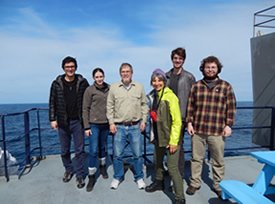
Subduction zones are where one plate dives below another and are responsible for great earthquakes and volcanoes. But how a new subduction zone forms is an enduring mystery of plate tectonics. Now, a team of scientists lead by the Seismo Lab are carrying out a large seismic experiment where we know subduction is nucleating today. In the remote ocean south of New Zealand, the South Island Subduction Initiation Experiment, team is using ocean bottom seismometers and other seismic sensors to measure crustal properties, including imaging the nucleating megathrust between two tectonic plates. The team is using the state-of-the-art seismic research vessel, R/V Marcus Langseth, owned by the National Science Foundation. Seismo Lab Director Michael Gurnis, Chief Scientist of the expedition, is joined by Joann Stock, Professor of Geology and Geophysics, and Caltech geophysics students Erin Hightower, Ethan Williams, Erich Hertzig, and Benjamin Idini.
With Caltech graduate student Xiaolin Mao, Gurnis has been developing advanced computational models for how a new subduction zone forms. During initiation of subduction, new faults either form or existing faults reorient. Initially, the forces in a subduction zone are driven by plate motions, but eventually enough force builds up allowing the local slab to take over. This is a key transition from forced to self-sustaining subduction. Gurnis maintains that the area south of New Zealand, the Puysegur Trench, is making this transition. With scientists from the University of Texas Institute of Geophysics, the team aboard the R/V Langseth is making observations to test these geodynamic concepts in research funded by the National Science Foundation.
Please check out the news article and video from Otago News in Dunedin.
